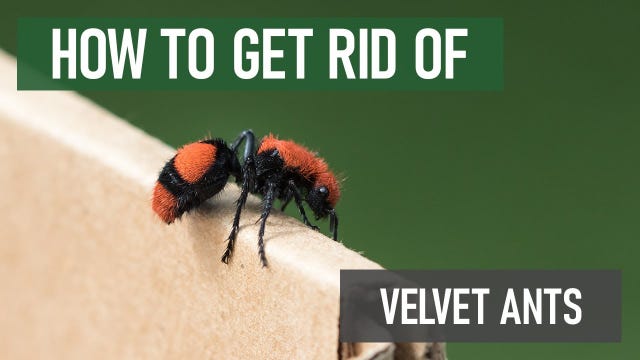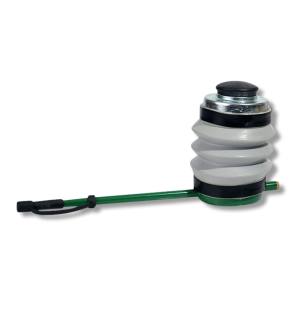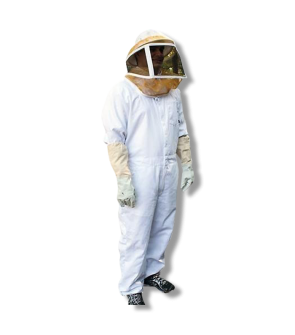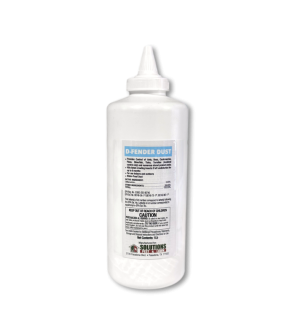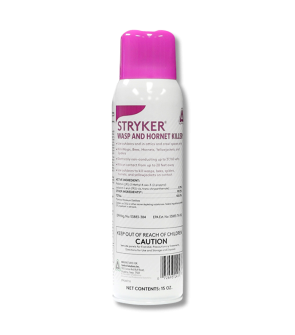Gain access to personalized product screening, the best pricing, rewards, and more!
Most Effective Products
Velvet Ant Control: How to Get Rid of Velvet Ants
This article is a general velvet ant control guide. Using the suggested products and methods will help you control velvet ant populations completely. Follow this DIY guide and use the recommended products; we guarantee 100% control of velvet ants.
The name velvet ant or red velvet ant is very misleading because, despite its appearance, this pest is a wasp. Their name comes from the furry female version of the velvet ant, which is wingless and often seen crawling across the ground. While known as the cow killer ant, cow killer, or cow ant due to the intensity of their sting, there is little truth to the name. This nickname appears to have just come from people exaggerating the pain to that of possibly killing a cow.
These wasps are common within suburban and agricultural areas throughout the northern half of the United States in Missouri, Connecticut, and the southern part of Texas and Florida. Usually, velvet ants are unaggressive towards people, but if disturbed, the female will sting. Despite their lack of predators, velvet ants are so well defended from their painful stings, difficulty being crushed with hard exoskeletons, and ability to release a foul odor.
Depending on the species, velvet ants display extreme sexual differences, with most male velvet ants having wings and physical differences other than those of wingless females. It is often hard to identify the male and female versions of the velvet ant species unless they are caught while mating. After mating, the female velvet ant invades other ground wasp and bee nests to deposit eggs into the bee or wasp pupae, which the larvae eat.
Though velvet ants are solitary pests, they can quickly grow in number since they have few natural predators. Male velvet ants are not considered dangerous for ornamental foliage since they feed on plant nectar and help spread pollen to other flowers. However, their larvae are considered parasites to beneficial insects like bees and wasps, which can reduce the amount of pollinators visiting your ornamentals.
Because velvet ants are solitary pests, most homeowners do not consider them a nuisance until they see eventual stress on plants or come into contact with their toxic stings. To decrease your chance of coming across this unwanted wasp in your yard, follow the steps and products listed in our DIY guide for complete velvet ant control.
Identification
Before proceeding with treatment, you must be sure the pest you encounter is a velvet ant. Misidentification can lead to using the wrong products and treatment approach, costing you time and money. If you are not sure you are seeing a species of velvet ant, here are some common characteristics to aid in identification.

- Velvet ants earned their name from their hair, which may be patches of reddish or orangish and black in body color. These pests often have black, white, silver, or golden body pattern markings. These hairs can be seen on the pest's head, thorax, and abdomen.
- Measure about 3/4 inches long with a body shaped like ants, except for a broader waist, whereas ants are more narrow. Males of most velvet ant species are slightly smaller than the female.
- Hard exoskeleton that cannot be easily penetrated, allowing these pests to invade nests of wasps and bees without being stung.
- Often, velvet ants are confused with ants due to their movement and shape, but they can be identified by their long, thick antennae that are straight in shape. With ants, their antennae are more elbow in shape.
- While male velvet ants have the wings you would expect from any wasp, female velvet ants do not have wings.
Use the description and image above to help you identify velvet ants on your property. If unsure, reach out to us by phone, email, or in person at one of our store locations with a photo or a sample of the pest in a sealable plastic container to aid in proper identification.
Inspection
Once velvet ants have been confirmed on your property, you can proceed with the inspection. This process will help you determine where velvet ants are found and the conditions allowing them to thrive. Determining this will help you determine where to focus your treatment applications.

Where to Inspect
Velvet ants live in open, sunny areas like lawns, gardens, non-shaded edges of forests, and pastures within urban and agricultural neighborhoods. They prefer sites with sandy soil, food sources that provide nectar like flowers, especially milkweed, and other available food sources such as wasps and bees that nest in the ground to feed their larvae.
What to Look For
From July to September, most velvet ants are seen crawling across the soil during the day in search of ground bees and wasp nests for future egg-laying activities and hovering or crawling on plants that produce nectar to feed themselves. Adult velvet ants feed on nectar from flowers and weeds. Male velvet ants generally fly low to the ground to find and breed with females. They are only capable of flying a few inches above the ground.
Female velvet ants will enter ground-nesting bee and wasp nests to deposit eggs near the host larvae and pupae, then leave to continue hunting. The velvet ant larvae feed on the mature larvae or pupae of the bee or wasp, becoming fully grown in a few days. Ground wasp nests will have a large circular hole with small piles of dirt gathered around the entrance. Ground bee nests can be seen as small holes in moist soils with small dirt piles surrounding these entrances.
Though rare for these pests to be eaten by predators due to their hard bodies and painful sting, when threatened, a velvet ant will release a squeaking sound from its abdomen and a foul odor produced by chemical glands in its mouth.
Treatment
Before taking on any treatment control, you will need to wear personal protective equipment (PPE) such as a thick long-sleeve shirt and pants, closed-toe shoes with socks, gloves, safety glasses, and a mask to aid against chemical odors and stings from the velvet ant. We recommend you cover up as much exposed skin as possible with a professional bee suit to prevent stings and direct chemical exposure.
It is recommended to perform dust applications on ground wasp and bee nests to eliminate breeding and feeding sites for velvet ant larvae, spray ornamentals with approved insecticide to deter adults from feeding on plant nectar, and then treat any flying or crawling velvet ants with a wasp spray. It would be best to perform these treatments at the beginning of July, August, or September.
Step 1: Spray Ornamentals with Supreme IT
First, treat ornamentals on your property with a residual insecticide like Supreme IT. Supreme IT Insecticide is a 7.9 bifenthrin suspended concentrate that classifies as a synthetic pyrethroid that works by interfering with up to 70 different types of insects' nervous systems, leading to paralysis and death. Once dried, this product will leave a 90-day residual to repel and kill wasps and other labeled insects.
This flowable product will need to be mixed with water and applied with a handheld pump sprayer or hose-end sprayer. For high-volume applications, we recommend using a hose-end sprayer. Supreme IT Insecticide may be used on ornamentals, flowers, foliage plants, shrubs, and ornamental trees in interior and exterior plantscapes. This product may also be applied to bedding plants.
Determine how much Supreme IT to use by calculating the square footage of the treatment site. To do this, measure the length and width of the treatment area in feet and then multiply them together (length X width = square footage).
To treat for wasps, mix the labeled rate of 0.25 to 0.5 fl. oz. of Supreme IT per gallon of water per 1,000 sq. ft.
Apply your solution over ornamentals and shrubbery, treating any leaves' top and bottom. Allow the product to dry completely before allowing people or pets to reenter the area. Before applying the mixed Supreme IT solution to the entire plant, test treat a small number of plants and watch for signs of sensitivity. Some plant species may be sensitive to the final spray solution.
Pests that make contact with the spray or its residual will have their nervous systems impacted and will die within several hours.
Step 2: Dust Ground Wasp/Bee Nest with D-Fender Dust
After you have sprayed ornamentals plants, treat any wasp burrows you have found with dry insecticidal dust like D-Fender Dust. D-Fender Dust is ready-to-use insecticidal dust made with 0.05% deltamethrin to treat ground wasps, wasps, bees, and other pests.
When pests come into contact with this pyrethroid product, their nervous system becomes affected by paralysis, leading to eventual death. With its moisture resistance, D-Fender Dust will continue to kill wasps and ground wasps for up to 8 months, thus eliminating food options for velvet ant larvae and adult female velvet ants since they are wasps.
With a handheld duster, apply this product to the entrances of ground wasp nests. Check back after two days and reapply if the nest is still active. Insects that make contact with the dust will die in several hours.
You may remove the ground wasp nest when the pest and their activities are no longer noticed. While wearing personal protective equipment, remove the non-active nest and destroy it to prevent the emergence of newly hatched insects and velvet ant larvae.
Step 3: Spray Stryker Wasp and Hornet Killer
Once you have applied residual treatments, you can treat individual velvet ants on-site with Stryker Wasp and Hornet Killer. This product is a prallethrin aerosol insecticide that can reach targets 20 feet away.
We recommend you stand 6 to 15 feet away from the target and spray at an angle to avoid any product drift. Wasps that come into contact with the spray will be knocked down immediately and die within several hours.
When using this aerosol product on wasps like velvet ants, it must be applied outdoors on calm, warm days when the wind is not continuously blowing hard.
Prevention
After you have removed velvet ants from your yard, you do not want these stinging pests to return. Here are some methods you can follow to prevent and repel velvet ants from reoccurring on your property.
- Deter ground wasps, bees, and velvet ants from settling in your yard with regular mowing.
- Since adult velvet ants depend on water and nectar, you must limit moisture in your yard. This can be done with regular pruning of overgrown foliage branches and leaves as the shade they produce helps to increase moisture in soil. This can also be seen with fallen leaves, which can be removed with raking. Address other causes of moisture build-up in your property, such as leaking plumbing, moist soils, and draining standing water sources for ground wasps and bees.
- Keep up with regular applications of your residual insecticides. Supreme I/T will last up to 90 days, so treatments are made every 3 months for year-round control. D-Fender Dust and Stryker may be used as needed.
- Continue to eliminate adult velvet ants in your point of view with Stryker Wasp and Hornet Killer. Do not attempt to crush, pick up, or make contact with your hands and feet, as these pests cannot easily be crushed.
Key Takeaways
What are Velvet Ants?
- Velvet ants, also known as cow killer ants, are solitary wasps that do not live in colonies like other wasp species and have an intense, toxic sting.
How to Get Rid of Velvet Ants
- To get rid of velvet ants, you will need to treat ground wasp and bee nests with D-Fender Dust to eliminate potential females and spray tolerant ornamentals with Supreme IT Insecticide. Eliminate traveling or flying velvet ants in your line of sight with Stryker Wasp and Hornet Killer.
Preventing Velvet Ant Reinfestation
- Prevent velvet ants in your yard by treating active in-ground wasp and bee nests with D-Fender Dust to eliminate food sources for velvet ant larvae and adult females. Spray ornamentals with Supreme IT to keep adult male and female velvet ants from traveling into your yard for food.






